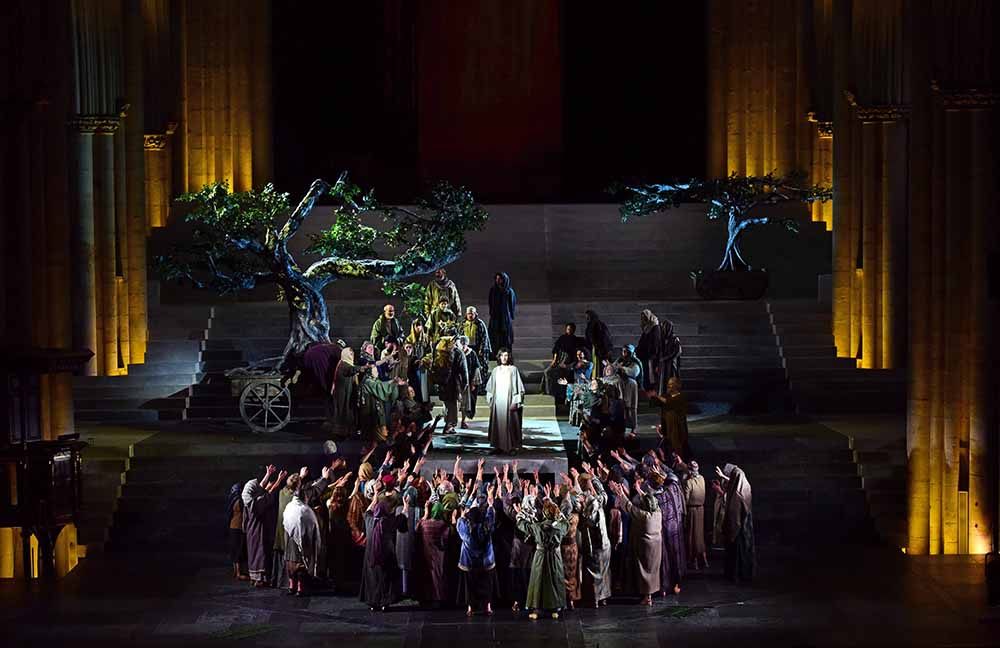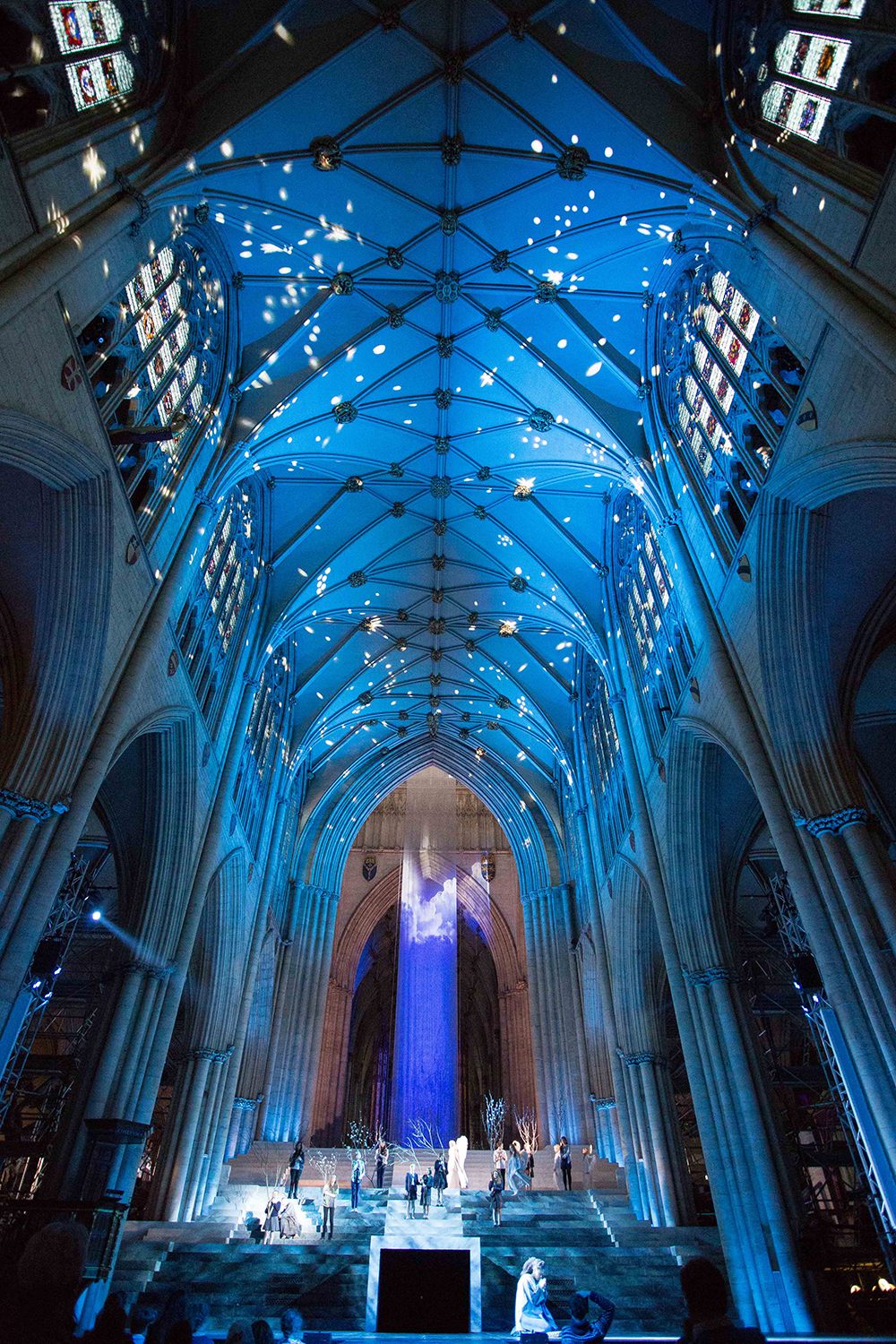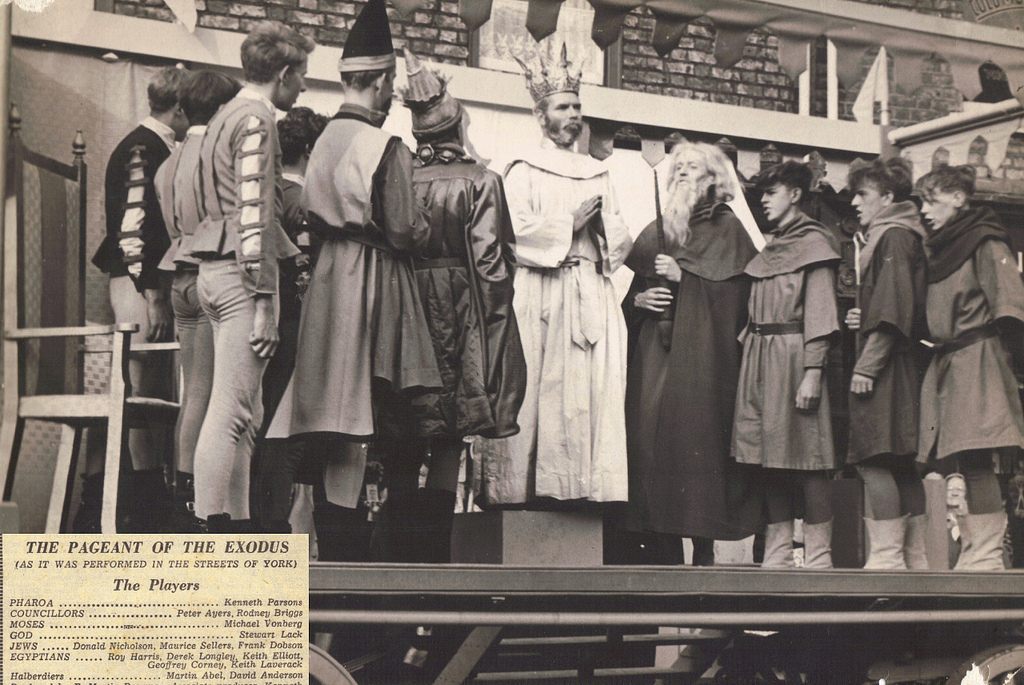The ‘Mystery Plays’ Banned by the Tudors Are Now Showing in an English Cathedral
God and Lucifer, co-starring again at last!

The York Mystery Plays at York Minster, May 2016. (Photo: Anthony Chappel-Ross)
Lucifer, the bringer of light, has been cast from heaven, his wings torn to bloody shreds and his once-white robes defiled. God, meanwhile, stands atop a flight of marbled steps, raising an anatomically correct Adam from clay as colorful birds flap overhead. At a cathedral in York, England, the human drama which will occupy the stage for the next four hours has begun.
These scenes are from the York Mystery Plays, a collection of 48 episodic pageants first written and performed in the 14th century. They’re now being revived at York Minster, the largest Gothic cathedral in Northern Europe.
Performances of the plays, each of which present a Bible story, were banned for their Catholic content by the Protestant Elizabethan court in the 16th century. But for 200 years before that, each dramatic episode was performed by a different guild, and took place on a series of wagons which were dragged about the city of York during the yearly festival of Corpus Christi. The “mystery” in the title refers not to a whodunit but to the ethereal miracles of religion, and perhaps stems from the Latin word for craft, ministerium.

The Last Judgment scene at the York Mystery Plays. (Photo: Anthony Chappel-Ross)
As in the Middle Ages, today’s revival performance is a huge community event—the cast numbers nearly 200 people, with more serving in backstage roles. Nearly all of them are local volunteers, and just one actor among the lot is a paid professional: Philip McGinley, best known for playing Anguy in HBO’s Game of Thrones, here appearing in a less warlike role as Jesus.
Mike Poulton, who has worked extensively with the Royal Shakespeare Company, was given the task of winnowing down the massive cycle and adapting it for a modern audience.
“In a good drama you need conflict, a struggle,” says Poulton. “What I did was take all the plays where there is a struggle and compile them into what I think is the greatest story ever told.”
In the Middle Ages, each play was performed on its own cart. Viewers could watch every one as they rolled by or wander about, picking and choosing their favorite stories. At the York revival, those stories, each running between 10 and 20 minutes, have been joined into a continuous epic. These include the enraged Herod’s massacre of the innocents, Joseph’s struggles with his wife’s divine pregnancy, and the grief of the apostles after Jesus’ bloody end. The plays run sequentially from the Creation through to the Last Judgment, with most focused on the events of the New Testament.

The interior of York Minster is an impressive backdrop for the plays. (Photo: Anthony Chappel-Ross)
In the process of adaptation, Poulton kept much of the original language. Characters speak in the same sort of jaunty alliterative verse as their medieval predecessors, and archaic words add historical flavor to the performance—expect to be Googling the definitions of “mickle” and “ilke” during intermission.
“Everybody cites the York plays as the gold standard of mysteries—they have a very long and impressive tradition,” says Dr. Sue Niebrzydowski, Senior Lecturer in Medieval English Literature at Bangor University. This tradition, she says, heavily influenced later English playwrights like Christopher Marlowe. She notes too that the plays would have been an important source of Biblical information for their largely illiterate audience. “It’s like seeing your church wall paintings brought to life,” she adds.

A 1957 student production of the York Mystery Plays taking place in the streets of York. (Photo: Keith Laverack/shutterstock.com)
Vivienne Faull, the Dean of the minster, also stressed the importance for medieval audiences of witnessing the plays. “They’re from a time when visual culture and aural culture were tremendously important, in a way they perhaps haven’t been since the advent of print,” she says.
The York plays as they are performed today are a heavily visual phenomenon. Big crowds of actors gather on stage to stone the adulteress or witness the Crucifixion; floodwaters (in the form of huge sheets of undulating blue fabric) cover the stage as the door of the Ark is closed, and the cycle ends with a great battle between the white-robed angels and their skeletal demonic counterparts at the Last Judgment.
The 2016 revival is only the second time the plays have ever been performed within the magisterial York Minster. It is also the first recorded instance since 1569 that the cycle has been put on during the festival of Corpus Christi, as it was in the Middle Ages. Faull hopes that this recaptures some of the spirit of the original performances, which took place during large community celebrations and helped to bring the town together. Massive amounts of planning have gone into this revival—those organizing it have had to work around the Minster’s demands as a tourist attraction, protected historical site, and active place of worship. Faull says that there is no telling when—or if—the plays will be performed here again.

The streets of York leading to York Minster. (Photo: Richard Penn/CC BY 2.0)
Despite their religious content, producer Nicola Corp stresses that the plays are accessible to audiences of all creeds or none. “It’s just as much a fantastic theatrical extravaganza as a spiritual experience, as just as moving regardless of faith,” she says. “It’s a story of good and evil, life and death, and it’s fundamentally an epic and deeply moving staging of the human story.”
Poulton agrees, adding that “all good plays show the facts of life, the truth of life—suffering, faith, joy—and this one gives you months’ worth to think about.”
















Follow us on Twitter to get the latest on the world's hidden wonders.
Like us on Facebook to get the latest on the world's hidden wonders.
Follow us on Twitter Like us on Facebook